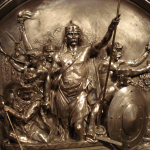 The Merovingian Dynasty gave birth to the nation of France. Merovingian, the title given to the Franks, derives from the name Meroveus/Merovech. Gregory of Tours mentions Meroveus as the son of Chlodio, the first king of the Salian Franks. Around 450, Meroveus went to Rome to gain support from the Romans for succession as king against an elder brother who aligned with Attila the Hun for the same reason. Priscus, a Roman diplomat and historian, wrote of Meroveus, “I have seen him, he was still very young and we all remarked his fair hair which fell upon his shoulders.” This statement supports the idea that Frank nobles distinguished themselves from the commoner and other groups by wearing longer hair, despite the fashion, and were called ‘Long-hairs.’ The Roman Master of the Soldiers, Flavius Aetius, welcomed Meroveus and accepted him as a friend and foederatus (Roman subsidized barbarian warrior). The Salian Franks fought with Rome at the Battle of Catalaunum (also known as the Battle of the Catalaunian Plains or Châlons).
The Merovingian Dynasty gave birth to the nation of France. Merovingian, the title given to the Franks, derives from the name Meroveus/Merovech. Gregory of Tours mentions Meroveus as the son of Chlodio, the first king of the Salian Franks. Around 450, Meroveus went to Rome to gain support from the Romans for succession as king against an elder brother who aligned with Attila the Hun for the same reason. Priscus, a Roman diplomat and historian, wrote of Meroveus, “I have seen him, he was still very young and we all remarked his fair hair which fell upon his shoulders.” This statement supports the idea that Frank nobles distinguished themselves from the commoner and other groups by wearing longer hair, despite the fashion, and were called ‘Long-hairs.’ The Roman Master of the Soldiers, Flavius Aetius, welcomed Meroveus and accepted him as a friend and foederatus (Roman subsidized barbarian warrior). The Salian Franks fought with Rome at the Battle of Catalaunum (also known as the Battle of the Catalaunian Plains or Châlons).
There are several legends derived from an earlier one recorded in a seventh- century history that states ‘Clodion (Chlodio) was sitting on the seashore together with his wife during the summertime when his spouse, while going into the sea to bathe, was attacked by a sea monster which was like a centaur. Having become pregnant at once, she gave birth to a son named Meroveus. In literature, a form of the legend was ‘adapted’ in the book Holy Blood, Holy Grail in which the authors maintain that Meroveus being born of a ‘fish’ meant that the Merovingian line was descended from Christ’s bloodline represented through the Christian symbol of the fish. The author, Dan Brown, popularized this theory in his novel, The Da Vinci Code. In researching the Franks and Merovingians, I found the account of Meroveus standing before the Roman elite quite intriguing and it pushed me further into the fascinating history of the 5th century.
